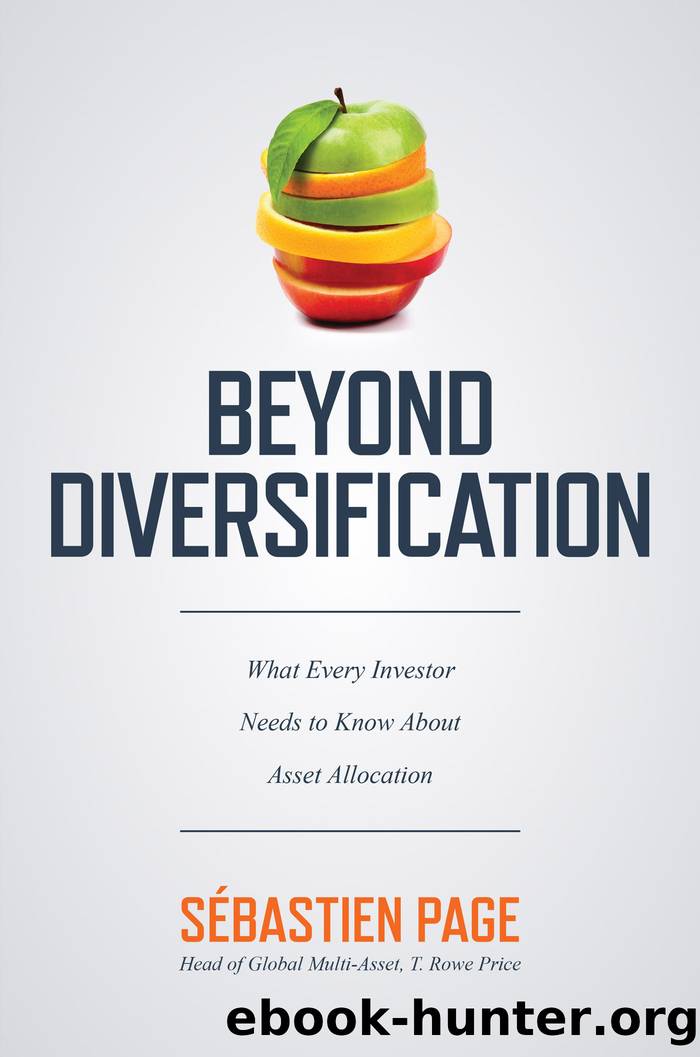Beyond Diversification by Sebastien Page

Author:Sebastien Page
Language: eng
Format: epub
Publisher: McGraw-Hill Education
Published: 2020-11-15T00:00:00+00:00
Scenario Analysis
Another approach to tail-risk estimation is scenario analysis, also referred to as stress testing. Like the risk regime framework, scenario analysis often marries quantitative and fundamental inputs. In the Global Multi-Asset Division at T. Rowe Price, we apply a wide range of historical scenarios and forward-looking shocks on our 200+ portfolios.
In its simplest form, historical scenario analysis is straightforward. We multiply current asset class weights by asset class returns from a historical episode:
Current asset class weights à asset class returns during a past crisis
Suppose your portfolio is invested 80% in stocks and 20% in bonds, and you would like to know how this portfolio would perform in another financial crisis such as the 2008â2009 meltdown. You could simply multiply 0.8 Ã the return of stocks during the crisis, plus 0.2 Ã the return of bonds during the crisis.
There are many applications for this framework: financial advisors can use it to help individual clients better assess their risk tolerance; asset allocators can stress-test their portfolio to determine whether they are properly diversified; plan sponsors can use it to manage expectations with their boards of trustees; and so on. Weâll revisit scenarios in Chapter 14 when we discuss tail-aware portfolio construction, but as I mentioned in Chapter 9 when we discussed the failure of diversification, there is a need for our industry to move scenario analysis from the back office (after-the-fact reporting) to the front office, where investment decisions are made.
Examples of past crises include the crash of October 1987, the global financial crisis (June 2008 to February 2009), the US debt downgrade (August 2011 to September 2011), the taper tantrum (May 2013 to June 2013), and the current 2020 pandemic crisis. For strategies that are managed against a benchmark, investors should consider upside scenarios as well. If the active portfolio is under-risked relative to its benchmark, by how much could it underperform in a market rally (âmelt-upâ) event? For example, a scenario dashboard could include a reflation scenario (March 2016 to December 2016).
Of course, to define the scenarios is not an exact science. We must make a judgment call on the start and end dates for each historical episode. I have found peak-to-trough scenarios to be useful, because they relate to the concept of maximum drawdown. When we use the marketâs peak as the start date and the trough as the end date, we ask, âHow bad can it get?â
An important, and often underappreciated, drawback of this simple approach to historical scenarios is that asset classes change over time. Fluctuations in sector weights within the S&P 500 provide a good example. The most unstable sector in the index has been technology. From 5% of the index, it reached a peak of 29% in 1999, during the dot-com mania. Then it declined back to a trough of 15% in 2005. With the recent rise of the tech giants (Amazon, Apple, Facebook), it now stands at 21%.
Over time, the S&P 500 index has become less exposed to cyclical sectors. In 2007, before the global financial crisis, the financials and energy sectors represented 31% of the index.
Download
This site does not store any files on its server. We only index and link to content provided by other sites. Please contact the content providers to delete copyright contents if any and email us, we'll remove relevant links or contents immediately.
International Integration of the Brazilian Economy by Elias C. Grivoyannis(88524)
The Radium Girls by Kate Moore(11900)
Turbulence by E. J. Noyes(7921)
Nudge - Improving Decisions about Health, Wealth, and Happiness by Thaler Sunstein(7549)
The Black Swan by Nassim Nicholas Taleb(6989)
Rich Dad Poor Dad by Robert T. Kiyosaki(6363)
Pioneering Portfolio Management by David F. Swensen(6208)
Man-made Catastrophes and Risk Information Concealment by Dmitry Chernov & Didier Sornette(5900)
Zero to One by Peter Thiel(5662)
Secrecy World by Jake Bernstein(4619)
Millionaire: The Philanderer, Gambler, and Duelist Who Invented Modern Finance by Janet Gleeson(4352)
The Age of Surveillance Capitalism by Shoshana Zuboff(4192)
Skin in the Game by Nassim Nicholas Taleb(4144)
Bullshit Jobs by David Graeber(4068)
The Money Culture by Michael Lewis(4052)
Skin in the Game: Hidden Asymmetries in Daily Life by Nassim Nicholas Taleb(3907)
The Dhandho Investor by Mohnish Pabrai(3681)
The Wisdom of Finance by Mihir Desai(3629)
Blockchain Basics by Daniel Drescher(3474)
